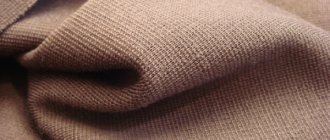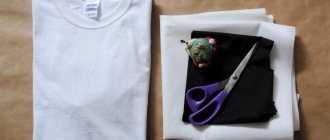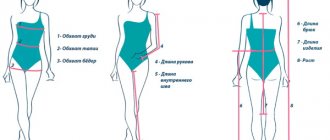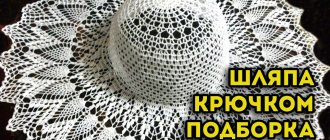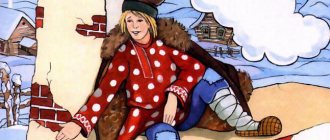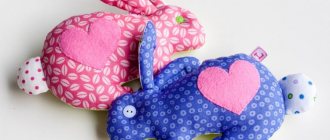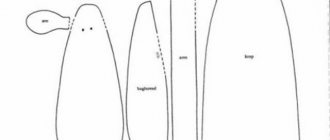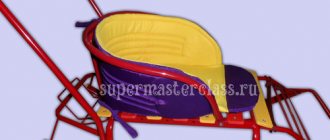Choosing knitted fabric for women's sweaters
When choosing a knitted fabric for sewing women's sweaters, take it into account:
- thickness;
- stretchability;
- density;
- compound.
In the table you can see what these indicators influence:
| Compound | Density | Stretchability | Thickness |
| For tailoring; cut; care; shrinkage; ability to absorb moisture. | For assortment; shrinkage; combination; selection of sewing needles. | For tailoring; cut; construction of patterns; choice of style. | Choice of threads and needles; cut; determination of seasonality. |
When choosing knitted material:
- Pay attention to the composition: a good fabric should contain 70-80% natural fibers, but sometimes you can prefer one that has a 50 to 50 ratio with synthetics.
- Check the canvas for electrification and clinging to the fingers. High-quality knitwear does not have a synthetic shine and is pleasant to the touch.
- Observe whether the material returns to its original shape after stretching.
- Hold the fabric up to the light for uneven weaves. If there are any, then the knitwear is of poor quality.
- They look at the cost. Cheap fabric, as a rule, turns out to be completely unsuitable.
High-quality knitwear will:
- pleasantly heavy;
- dense;
- drapes well;
- moderately stretchy;
- expensive.
Fabric calculation
Knitted sweaters for women are often combined or decorated with other materials. Blouses made of stretch fabric often have satin or guipure inserts. Sometimes knitwear is even combined with polyester.
With a fabric width of up to 100 cm, it is calculated for a sweater of size 48 inclusive: folded together with hem allowances for the bottom of the length of the product (2 pieces) and sleeves. If the canvas has a width of 140-150 cm, then all calculations are the same as in the first case, only the length of the product is added by one.
The length of the fabric is increased if the model has:
- larger than 48;
- complex style;
- pattern that needs to be combined;
- pockets and collar.
Canopy dress
This is the so-called canopy dress. Stretch fabric works great.
The dimensions of the canvas are approximately 130-150 cm.
Fold the fabric four times. Measure your hips. Measure from the side where the fold is 1⁄4 of the measurement and add a couple of centimeters for a loose fit.
Then you need to mark the vertical to a height of 0.5 m. Open the folded fabric and stitch on the resulting segment. The corners should be drawn with a semicircular line.
Excess fabric should be cut off. Mark the neckline 5*30 centimeters. Finish all seams. The dress without a pattern is ready. For summer clothes, light, breathable fabrics are suitable.
What do you need to sew a knitted blouse?
To work with any style of knitted sweaters, pre-prepare:
- sewing machine;
- overlock;
- pins and needles;
- soap or chalk;
- square;
- extended ruler;
- well-sharpened scissors for cutting;
- ready-made patterns.
Materials and tools
To work you will need a standard set:
- sewing machine;
- threads;
- needle;
- scissors;
- ruler;
- tape measure;
- chalk or soap;
- paper or tracing paper;
- pins.
You can use your old T-shirt instead of a pattern. Then you won't need paper at all.
If desired, you can use additional accessories: ribbons, buttons, bows, rhinestones, laces. It is also worth considering how the cut areas will be processed. You can overlock them, trim them with braid, piping or bias tape.
How to cut knitwear?
Women can successfully create unique and original images by sewing their own clothes. For a beginning seamstress, if you have clear instructions and all the necessary tools, it will not be difficult at all to create a special item, for example, a jacket. Knitted products of simple and complex styles come out equally decent both with and without patterns.
When cutting blouses made of non-woven material, several nuances should be taken into account:
- the canvas must be cut exclusively with sharp scissors;
- patterns are taken with allowances marked on them;
- finished patterns are secured either with pins or something heavy;
- if it is necessary to fold the material in half, it is swept away not only around the perimeter, but also in other places;
- knitwear is cut lengthwise, except for the places marking the armholes and neckline.
Historical reference
Judging by its current appearance, it is difficult to imagine that this outfit used to serve as clothing for loaders. It provided complete freedom of movement, and large pockets contained all the tools necessary for work - scissors, gloves, etc. Much later, only in 1937, at one of the fashion shows, designer Claire McCardell presented long hoodie dresses in a completely different light. The public began to take an interest in them, and some girls immediately rushed to try them on. Now a similar outfit, decorated with bright decorative elements, is available in the collections of all famous designers.
Building a basic pattern
To create a basic pattern for a knitted sweater, take the following measurements:
- chest semicircumference (SBC);
- product length (DI);
- shoulder length (HL);
- sleeve length (SL).
Before sewing knitted sweaters for women, it is important to take measurements and make a cut.
Algorithm for creating a pattern:
- The drawing begins with the construction of the front and back parts of the product.
- Draw a rectangle on thick cardboard, where AB is pog, AC is di.
- From A, a distance equal to r/3 is retreated downwards and G is marked.
- Horizontal lines are drawn from G and G1 is marked at the intersection with the side of the rectangle.
- AB is divided by 3 and marked A1 and B1.
- From them to GG1, vertical straight lines are drawn, obtaining G2 and G3 at the intersection.
- GG1 is divided in half and G4 is placed.
- From it they go down to the CD, drawing a vertical line. At the place of suppression they receive C1.
- For the armhole, bisectors with lengths of 2 and 1.5 cm are drawn from the corners G2 and G3, thereby obtaining G5 and G6.
- A1, G5, G4, G6 and B1 are connected using a smooth line.
- For the neck, a distance equal to dp is retreated from A1 to the left, A2 is marked.
- From A downwards put 2 cm and get A3.
- A2 and A3 are connected by a sliding line.
- On the front part, step back from B1 to the right, marking B2, and from B - 5-6 cm down, getting B3. The resulting points are smoothly connected.
- Everything unnecessary is erased.
Construction of a drawing for a set-in sleeve of a sweater:
- Build a rectangle with sides AB = linear/3 t AC = other.
- To obtain point O, descend from A to a distance equal to half a linear distance.
- A parallel AB is drawn from it. The intersection with BD is marked as O2.
- The resulting rectangle is divided by lines into 4 equal parts.
- The top and bottom vertices of half the rectangle are marked as B1 and B2.
- Points O2, B1 and B1, O are connected.
- A straight line is drawn from B1 downwards and the intersection with CD is marked as B3.
- To obtain B4 and B5, a distance equal to half the semicircle of the hand is retreated in 2 directions from B3.
- Next, according to the drawing, the details are shaped, after which the extra lines are erased.
- If the hips and chest are very different in size, then the bottom of the product is widened by the difference between them.
Fee for plus size ladies
This dress is for plus size people without a pattern; it will help hide all imperfections and highlight beautiful shapes.
For the upper part of the product you will need a piece of 1.5 m, leave 10 cm for the length from the shoulders to the waist. Fold the fabric in half and cut it.
Leave 30 centimeters for the width of the sleeves. Set aside 50 cm from the bottom contour of the product.
The distance between the two sleeves is 1⁄2 the size of the hips + 10-13 centimeters. Finish the sleeves with double stitching and make a drawstring. Make a beautiful satin ribbon.
Finish processing the skirt. Sew and finish all seams. Create beautiful and even folds on the waist line.
Sew two parts of the dress. Sew the hem with a double seam. Overlog all seams.
The dress with a chic floor-length skirt is ready.
Using ready-made patterns
The finished patterns are laid on the fabric and secured until immobile.
The image is outlined with tailor's chalk or a bar of soap, taking into account allowances for hems and seams. Next, all parts are cut out and basted. After fitting, the parts are machine stitched. If there is a collar, then 2 additional fabric strips with a width of 2.5 cm are prepared for it. They must be cut on the bias. At the very end, sleeves are sewn in, complemented by cuffs.
Summer blouse
Every fashionista has a summer blouse in her wardrobe for warm days. It is usually sleeveless, and sometimes has short or 3/4 sleeves.
Typically, light, flowing materials such as chiffon and silk are used for such a blouse. The color scheme of blouses for summer is light, pastel, bright.
Old T-shirt as a pattern
Knitted sweaters for women are easy to design and sew. Having learned this, you can easily create various models for further combination with other clothes. The principles of making blouses from soft stretchable fabric are quite simple and understandable.
To sew a knitted sweater, a used T-shirt can serve as a base.
It is ripped open or circled whole. A T-shirt disassembled into parts will suit complex styles, and an ordinary one will suit simple ones. But with such an alternative pattern, the neckline of the future sweater is increased on the chest.
Dress with a scarf
For this style, you need to take two scarves measuring 1.5 * 1.5 m. During the work, you will need additional elements for decoration. This cut of a dress without a pattern is suitable for girls with curvy figures.
Stages of work:
The two were made to be connected with the front side, to distribute the correct arrangement of the pattern. Baste the seams, departing 20 centimeters from the front edge, measure 23 cm from the back side. Sew all parts and iron them.
Using a pencil, mark the line of the back. Use tape to trim the free edge.
The straps are sewn to the edge at chest level and cross at the back. An elastic band is sewn under the bust.
The dress is ready, you can put it on and go for a walk around the beautiful evening city.
Setting up a sewing machine, installing a needle for knitwear
Before sewing a knitted product, set a stitch with a length of 2 mm on the machine and check the stitching on the flaps. In this case, you should also choose a needle with a rounded end.
Such a device will pass between the knitted fibers, correctly forming loops.
Elegant styles
With each fashion season, designers delight the fair sex with a wide variety of new products with beautiful prints and unusual styles. Recently, a trend has emerged for knitted blouses and tops with various inserts, for example, leather and lace.
Also, in recent years, classic blouses in pastel shades have not left fashion catwalks. Knitted products are unpretentious in use and do not require special attention. Young girls love these models for their simplicity of styles, bright colors and interesting prints.
Features of working with knitwear. Useful sewing tips
Beginner seamstresses are recommended to begin their sewing work with basting. Machine processing of parts begins only after careful fitting of the temporarily hand-sewn product. With this approach, the risk of size errors is significantly reduced.
When processing the edges and neckline, the use of bias tape is allowed. For sweaters with an ethnic flavor, choose satin ribbons in rich colors or with ornaments. A product with a similar design acquires freshness and originality.
To prevent a knitted sweater from becoming too tight, the stitches are made with a margin. Be sure to try to make sure that the machine stitch matches the basted seam. The thread tension when sewing should be moderate (about 5). Suitable seam variations are selected by testing on scraps or scraps of fabric.
To maintain the elasticity of the knitwear, the cut parts of the future product are stitched with a narrow zigzag stitch with a width of up to 1 mm and a length of 3 mm. It is advisable to sweep away the details using thin threads. To finish the shoulder seams from the inside of the product, use bias tape or tape - this way they will not stretch. Seam allowances are sewn with an overlocker or a large zigzag stitch. For the same purpose, the lower hems are not done too tightly by hand.
To sew your first items yourself, choose light styles without:
- a large number of parts;
- unnecessary layers;
- folds
When the machine skips stitches under the knitted fabric when sewing, place thin paper, such as newspaper or wrapping paper. Fabrics with weak elasticity are slightly stretched when stitching. For crooked or gathered machine stitches, loosen the presser foot so that it puts less pressure on the fabric. To avoid pulled seams, the threads on the bobbin are wound slowly. Very thin knitwear is laid underneath with newspaper layers to give it the missing thickness.
Knitted sweaters for women have many styles and creation methods. Clothing made from tight-fitting fabric does not require ironing and fits even the fat ones. Blouses with excellent thermoregulation are worn in any season.
The details of the sliding knitwear, before placing them under the machine, are first sewn to each other by hand. It is very important to remember when working with knitwear that basting always goes in one direction, and subsequent sewing - in the opposite direction. With this technique, the displacement of parts is completely blocked.
An adhesive pad that saves knitwear from stretching when sewing is used for:
- neck;
- pockets;
- cuffs;
- below.
Starch or flour paste can also save the canvas from stretching. This sticky solution is used to treat the edges of the product before sewing. The finished item is subsequently washed to remove it from the fabric.
Instead of using paste under the knitwear, you can put:
- toilet or wrapping paper;
- paper towel;
- napkins.
The hems are sewn together with an overcast stitch.
The following machine stitches are suitable for working with knitwear:
- knitted;
- double;
- flat;
- zigzag;
- overcast;
- stretch;
- straight;
- universal.
Special Jersey needles are used for natural and dense fabric, and Stretch for thin fabric mixed with viscose.
Superstretch needles are suitable for working with:
- micro oil;
- lycra;
- biflex.
It is convenient to stitch and hem with a double needle:
- bottom of the product;
- armholes and sleeves;
- neck;
- collar stands;
- cuffs
Description of the model and its advantages
Almost everything is allowed with this outfit. The hoodie dress fits perfectly on pregnant women, plump ladies choose it, and young fashionistas create real trendy compositions based on it. Long and short, evening and casual, made of chiffon and tight knitting, this dress always looks stylish and presentable. It’s difficult to list all the positive aspects of this outfit, but let’s highlight the main ones:
- Multifunctional - it is simple, convenient, versatile and always elegant. This dress can be worn to a party, a walk or sports. There are a lot of variations; it is chosen by ladies with completely different statuses and positions in life.
- Comfort – this quality is especially valued by people leading an active lifestyle. People love the dress for its warmth and comfort, because it will warm you up in bad weather and protect you from rain and wind. The variety of materials used allows you to wear this outfit at any time of the year.
- Compatibility with different styles - the right shoes, jeans and accessories allow you to create a lot of new fashionable looks from classic to sports, glamor or daring and romantic boho.
- Individuality - creating such an outfit with your own hands will give you the opportunity to fully express it, and experienced craftswomen advise not to limit your imagination either in the choice of material for the dress or in the amount of decor on it.
Master classes on self-tailoring sweaters for women with and without patterns
Presentations teach beginners how to sew any styles of knitted sweaters.
Off the shoulder style
A dropped shoulder on the product can replace short sleeves.
It also hides the fullness of the shoulders. Sleeveless models or patterns are taken as the basis for the manufacture of such a sweater. Lines on the sides and shoulder lengthen both the front and back of the product. The pieces joined together will subsequently create a new shoulder length. After cutting, the cut out parts of the jacket are ground to 3 cm in width at the neckline and armhole.
Short sleeve style with guipure
A summer version of a blouse with short sleeves made of fine wool and with a guipure insert is made as follows:
- They take measurements.
- Drawing a pattern.
- The upper part of the base to the level of the beginning of the chest will be intended for guipure insert, and the rest of the lower part will be for knitwear.
- When transferring the pattern onto the fabric, allowances for freedom of movement (10 cm) and for seams are taken into account.
- After preliminary overcasting, the cut out parts are sewn together on a typewriter.
Long sleeve style with buttons
For a sweater with long sleeves with buttons, the pattern differs in that the front part of such a product consists of 2 shelves. Additional details also include strips of fabric allocated for fastening strips. Sleeves can be one-piece or raglan.
If there is no pattern, then knitted items can be sewn without one by following the pattern according to the measurements taken directly on the fabric. One-piece sleeves are drawn together with the front, smoothly connecting the sides of the jacket with the bottom line of the part (sleeve).
Zip style
A model of a sweater with a zipper is made similar to a product with buttons, but instead of them, a fastener is sewn into the edges of the front shelves. The zipper can be the length of the entire product or only reach half of it.
Model with lace
A ready-made knitted sweater is often combined with lace. Inserts are made from it, which are sewn overlapping onto the knitted product.
Lace appliques on sweaters are found:
- ahead;
- behind;
- On the sides.
Model with lurex
Knitwear with lurex when making blouses from it does not require too large seam allowances and free movement. This material is cut without backing, directly on the fabric. To prevent it from slipping, it is spread not on bare surfaces, but on lined sheets, for example. The edges of knitwear with lurex must be machine stitched in a zigzag pattern so that they do not fray later.
Knitted sweaters for women can be sewn even without a pattern, using, for example, an old product as a basis. This technique will be especially useful for beginners who are encountering modeling for the first time. For the same purposes, ready-made patterns are used.
Algorithm for sewing a bat-shaped sweater from knitwear with lurex:
- They take measurements.
- The fabric is folded in half so that its wrong side is on top.
- For the neckline, set aside 3 cm from the fold downwards, and 9 cm to the side.
- The shoulder and sleeve lengths are set aside from the neckline.
- The waist and hip circumferences are divided into 4 and also plotted along their lines.
- The bottom of the model and the edge of the sleeve are smoothly connected.
- All lined parts of the product are cut out and sewn.
Sweater jacket
You can easily make a new sweater out of an old sweater.
For this:
- cut off and remake the neck;
- cutouts are made on the sleeves or shortened to a length of ¾;
- sew the product on the sides to achieve a fitted silhouette;
- parts made from other materials are inserted instead of the cut parts.
First option
- The most suitable fabric option is linen.
- Take waist measurements.
- The neckline of the dress will be V-shaped.
- Determine the highest point of the cutout, where the straps will be located.
- Now you need to find the lowest point. It will define your cleavage.
- If the shirt has a pocket, it should be cut off.
Where to begin:
From the top button on the shirt, measure down to the lowest point of the neckline. Approximately 19 centimeters. Decide on the waist width. To do this, you need to take 1⁄2 of your waist size + 2-3 centimeters. From the waist up, draw 18 centimeters. This is where the armhole will come from.
Measure 11-12 cm from the buttons. The straps will be located here. Connect all the marks together. It begins, an outline emerges. From all marked lines, retreat 1-2 cm to the seams.
Now you need to cut: along the waist line, along all marked lines. Now start processing the back. Draw a line 18 cm from the waist.
Cut along the line, leaving 1-2 cm for seam allowances. You should have 2 pieces for the top. Place them right side together and sew.
Make undercuts. This is done to ensure that the top fits your figure.
Draw a line at the level of the straps. Divide in half. Draw a line. You should get a triangle. The resulting line needs to be stitched. Now all the edges of the top need to be folded 2 times and stitched on a sewing machine.
Now you need to make the straps. They can be made from a sleeve. The width of the strap is approximately 2-3 cm. Fold the edges of the strip towards the center and bend it in half again. Run a line along the edge. Try on the top. And at the highest point of the top, mark the location of the straps and then sew.
All that remains is to sew on the skirt. To begin, unfasten all the buttons. Use a wide seam to sew the entire length. Using one thread, gather the fabric into folds. Distribute evenly over the entire length.
Attach the bottom to the top. First, connect everything using auxiliary pins. Sew two parts. There you go!
How to decorate the finished product?
It is advisable to think through the decor for clothes in advance, even before the item is created.
Finished knitwear products are usually decorated with:
- crocheted flowers;
- fur or leather appliqués;
- rhinestones;
- sequins;
- beads;
- hand embroidery from floss.
Making knitwear yourself is not a difficult task. With the help of a sewing machine and tailoring skills, it will not be difficult for a woman to replenish her wardrobe with original and stylish sweaters.
Sweatshirt with scalloped collar
For beginners, this cut option is perfect.
To sew such a model, first of all you will need knitwear, some guipure, thread, a sewing machine, and non-woven fabric. Patterns and their measurements apply to size 44.
- You need to cut out all the details, leaving 1 cm for seams.
- Place the guipure elements onto the main fabric and sew with a basting stitch. Connect the threads first on the yoke, why on the shoulders.
- Grind off the sleeves, sew them into the armholes, but so that the guipure does not slip along the edges of the yoke.
- Sew the side seams.
- Cut out the remaining components: the placket at the bottom, cuffs, neckline, leaving a centimeter margin for stitching.
- Attach a pair of buttons vertically to the collar.
- Pick up the excess threads after the overlock stitch and iron the finished garment.
If desired, complement the model with different decor: stripes with animals, flowers, symbols, stickers. You can place a print, drawing, or embroider a bright inscription on the finished product.
